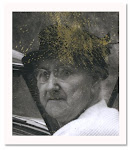This is one of those shots that would quickly get thrown back in the bin when I'd be sorting. It's in the category "pose for grandma" which is generally pretty doggone borin'. However, there's not much you can do when the shot comes glued in an album. So since I'm having a busy day I'm going to subject you to this category. I'd have preferred it be "eating watermelon" or "cutting the cake" or "fart fairies" or even "pigs eating watermelon." Yeah, I'd really have liked it to be a pig eating watermelon shot.
We'll give this one a subcategory...ummmm...girls standing behind garden, no wall, no garden, no...girls standing in front of telephone pole. Yeah, that's it.

Click on image to see it larger, though I don't know why.
Category: Pose for Grandma; subcategory: girls standing in front of telephone pole.
Check your own collections for more.

















I'm drawn to this photo, not for its image, but for its paper. I have a few photos with that very same frame with its corner points of my maternal grandparents, taken in Ontario, Canada about 1927-1928. It makes me wonder how popular this photo paper style was and how extensively it was used.
ReplyDeleteI know there's someone out there who will know the answer to this. Lost Gallery has had some great posts in the past with a nice variety of frames.
DeleteI don't know how popular it was but Canada and the US are the only places I've seen it from, and some are dated into the 1930s but not later.It can turn an ordinary photo into something else.
ReplyDeleteSee, I knew there was someone brighter than me who'd know something.
DeleteBy the way folks, if you haven't visited One Man'sTreasure you're missing some wonderful writing and images:
http://junkshopsnapshots.blogspot.com/
Actually, it's projected. It's a mask placed in an enlarger. The areas that print black would have been clear and the white areas, black. Every so often, you'll find one where the border is soft. If the image is in focus, the negative was dense, requiring a longer exposure, causing the border to "bleed" from the extra light.
ReplyDeleteWhy had I blocked this from my brain? Thank you for clearing this up.
DeleteFolks, another site worth following:
http://thenewfoundphotography.blogspot.com/